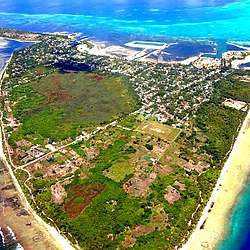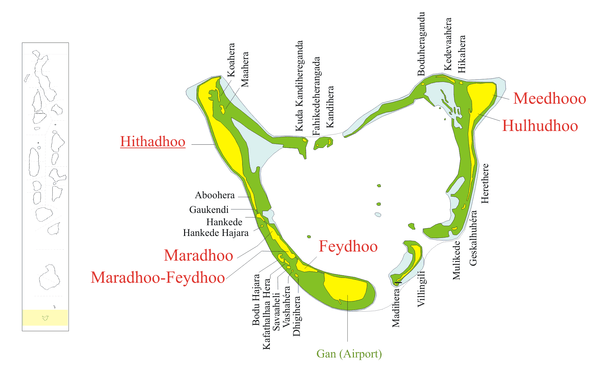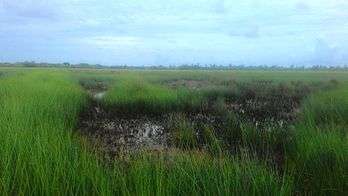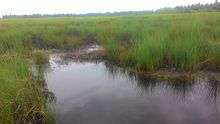Meedhoo (Addu)
| Meedhoo މީދޫ | |
|---|---|
| Island | |
 Hulhumeedhoo Aerial view with Hulhudhoo on the left (south) and Meedhoo on the right (north). | |
 Meedhoo Location in Addu Atoll  Meedhoo Meedhoo (Maldives) | |
| Coordinates: 0°35′01″S 73°14′03″E / 0.583724°S 73.234041°ECoordinates: 0°35′01″S 73°14′03″E / 0.583724°S 73.234041°E | |
| Country | Maldives |
| Geographic atoll | Addu Atoll |
| Administrative atoll | Addu City |
| Distance to Malé | 530 km (330 mi) |
| Area | |
| • Total | 1.99 km2 (0.77 sq mi) |
| Population (2014) | |
| • Total | 1,871 |
| • Density | 940/km2 (2,400/sq mi) |
| Time zone | UTC+05:00 (MST) |
Meedhoo (Dhivehi: މީދޫ) is the oldest populated island in Addu Atoll (also known as Seenu Atoll) in the Republic of Maldives, having been settled between 1000 and 500 BCE.[1] Its name comes from the original Indo-Aryan settlers; Meedhoo means "Big Island" in Sanskrit. Meedhoo is located in the northernmost tip of Addu Atoll.
History
The original settlers were Divehi people of Aryan origin. An Arab traveller by the name of Yoosuf Naib planted the seed of Islam and built a place to worship Allah in the 12th century; this became the country's first mosque. The island has since been known as a centre of learning and Islamic religious education, famous for the scholars it has produced. Since the 16th century, eight natives of Meedhoo have served as fandiyaaru, or qazi, at Malé. To this day, Meedhoo's Ulamma and other ecclesiastics hold their own with those of the capital.
Meedhoo is one of the largest islands in the Maldives. Despite its distance from the capital Malé and its comparatively small population, Meedhoo has maintained a disproportionate importance in Maldivian affairs.
The oldest cemetery in the Maldives, Kōgaṇṇu, is located in Meedhoo.[2]
Districts of Meedhoo
Fen'aa Avashu and Dheshenaa Avashu are the main two districts of Meedhoo. Dheshenaa Avashu lies to the north, while Fen'aa Avashu lies to the south.
Landmarks
There are many landmarks located in the island of Meedhoo. Including the ancient cemetery in the Maldives, Kogannu.
Other landmarks include newly finished Eedhigamooli Beach, the Kogannu Beach, the Hulhumeedhoo Kalhibih Beach and the Hulhumeedhoo Kilhi.
Hulhumeedhoo Kilhi
Hulhumeedhoo Kilhi is a large marshy area which covers most of the land area of Hulhumeedhoo (it covers most of Meedhoo and Hulhudhoo). "Kilhi" usually means either Lake or Mangrove in Dhivehi language of Maldives. But here it refers to the large marshy area where hundreds (or thousands) of freshwater ponds (most of them circular shaped and measures around 7-15 feet in average) are located. The ponds are known to have a few freshwater fish species found all year round.[3] The freshwater fish species found include, Greenstripe Barb (known by the locals as 'Fenfila'), Whipfin silverbiddy (known by the locals as 'Foo-tu-mas', which literally means '1 foot fish' even though they usually do not grow to that length) and a species of Freshwater Eel.[4]
The Hulhumeedhoo Kilhi is a common location where Marsh Wildfires happen 3-4 times every year. The fires could be intentionally started by the locals or could be started naturally.

See also
References
- ↑ "Koagannu cemetery, Meedhoo island, Addu Atoll". ExploGuide. Retrieved 2017-06-21.
- ↑ "Koagannu cemetery, Meedhoo island, Addu Atoll". ExploGuide. Retrieved 2017-06-21.
- ↑ "Mathikilhi | Meedhoo.com". www.meedhoo.com. Retrieved 2017-06-21.
- ↑ "Freshwater fish of Maldives". fish.mongabay.com. Retrieved 2017-06-21.
External links
- Meedhoo - Inhabited Island - Seenu Atoll isles.egov.mv
